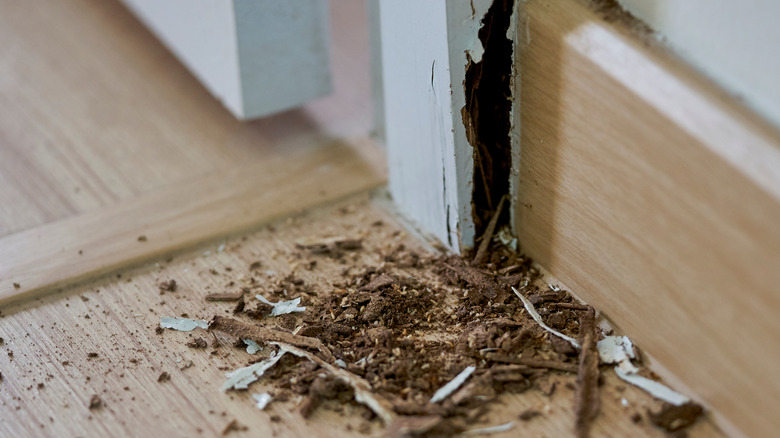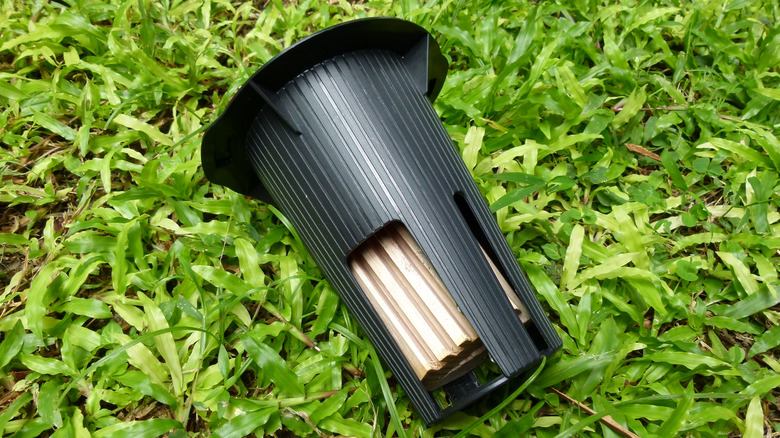Yes, You Can DIY Termite Bait Stations, But Here's What You Need To Know First
Termites aren't just a bit of a nuisance. Extermination of an infestation and the resulting remediation can take a significant chunk out of your household budget. When discussing ways to get rid of termites, toxin-filled termite bait stations inevitably come up. DIYing these nifty traps may seem like a cheaper option, but you risk wasted effort. Not all baiting systems are made equal, homeowners generally don't know how to properly monitor stations, and an experienced professional knows which termite bait station brands and active ingredients work best (or are even legal) in your area. Plus, you could wrongly identify the pest. For example, winged ants vs. termites: Can you tell the difference so you can properly treat the problem?
Bait stations consist of protective housing and a stick made of a material attractive to hungry termites, like paper, cardboard, timber, or cellulose, treated with slow-acting insect growth regulators (IGRs), which stop the bugs from molting, killing them. This bait stick is inserted into plastic casing with holes in it (the station), which is placed in your backyard above or below ground. When foraging termites encounter the bait stations, they take the poison inside back to their colony, eventually destroying it. Sometimes, regularly monitored stations are first baited with untreated wood as a way to assess where the termite colony is or whether there's a termite threat at all. If they're found, the untreated wood is swapped with toxic bait.
Know the risks before deciding to DIY termite bait stations
UCANR termite bait research from 2023 found that termite bait stations monitored by pest experts controlled these annoying insects in all studied houses, but the general consensus from pest experts is that do-it-yourself stations succeed less often. Termite bait stations designed for non-professionals are available in hardware stores, and instructions on how to make bait stations using a few simple tools and store bought or upcycled parts abound. While these homemade stations function similarly — perhaps even identically — to the systems a pest controller would install, there's one aspect homeowners struggle to get right: Rigorous monitoring. If the stations aren't regularly checked and homes inspected for signs of termites, how will you know if they're working?
After all, the stations don't attract the termites; the burrowing bugs literally stumble across them in their travels, so where the stations are placed in a yard matters. Dry weather pushes termites down into the soil, potentially missing above-ground stations, and consumer termite bait stations are often small and sealed shut, making them impossible to check on. Perhaps the stations are faulty and need replacing? Whatever the situation, poorly monitored bait stations are considerably less effective. Only by scrutinizing and analyzing each and every station on a schedule can you be sure the system is working optimally. And that, many experts believe, is a job best left to the professionals. Plus, getting it wrong could mean termites are munching away unchecked just below your feet.
The how-to: DIY termite bait stations for diligent homeowners
Still want to DIY termite bait stations? If you have a few simple tools to hand and are reasonably confident that you can identify the correct pesticide to use, place the bait stations in the right spots in your yard, and stick to a strict monitoring schedule, it's definitely an option. And one that's certain to save you money too. According to Consumer Affairs, U.S. homeowners can expect to pay $1,500 to $3,000 on average for bait treatment, or $7 to $12 per linear foot (per CNN), not including the cost of regular pre- and post-installation inspections and system changes — up to $400 annually (via HomeGuide).
First, use a box cutter to cut three-quarter of an inch wide holes into a foot-or-so long PVC pipe fitted with end caps or a thick plastic bottle (think empty laundry detergent or Gatorade bottles). Buy pre-made termite bait sticks or make your own by tightly rolling pieces of cardboard from an old box into cylinders and soaking them in liquid termiticide with diflubenzuron, hexaflumuron, hydramethylnon, lufenuron, or noviflumuron as the active ingredients for about five minutes. Always follow the pesticide manufacturer's dilution instructions and ensure you wear protective gloves and goggles.
Then, insert the bait sticks into the plastic housing and bury the stations around your home, no more than 4 feet from your foundations and up to 20 feet apart. To find the colony, leave damp cardboard boxes outside and look for evidence of mud tunnels.

